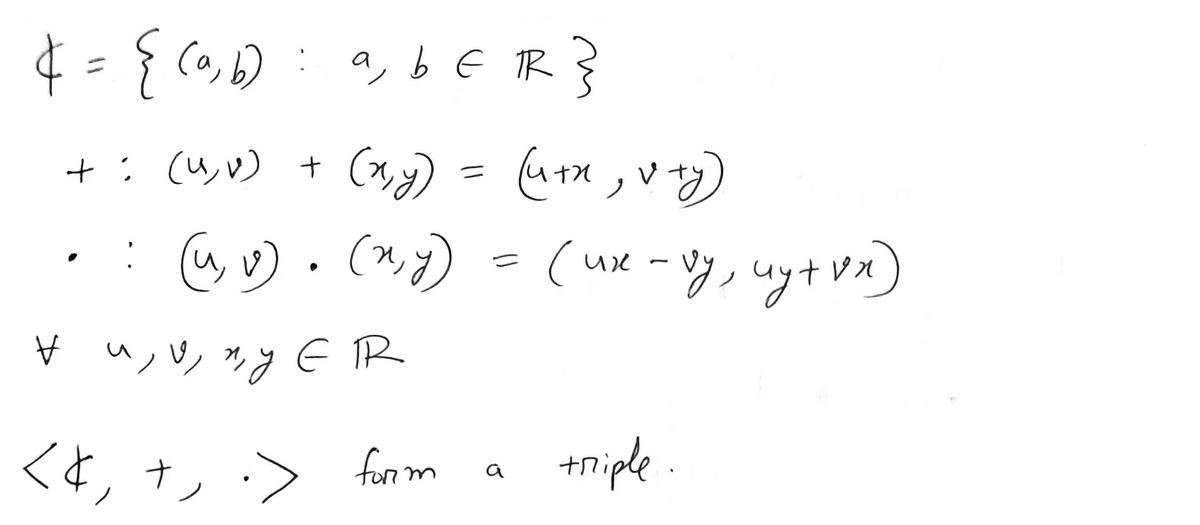Let C denote the set of all ordered pairs (a, b) with a,b & R. L.e., C:= {(a,b): a,b € R}. Define addition + and multiplication of such pairs by (u, v) + (x, y) = (u + x, v+y) and (u, v)⋅ (x, y) = (ux - vy, uy +vx) for all u, v, r, y € R. Together they form a triple < C, +, . >. (a) Show that multiplication is associative in . (b) Show that every element (a, b) E C has a negative, and every element (a, b) € C# has an inverse. (c) Prove or disprove: The system of real numbers R is isomorphic to the system Rx {0}, +, . >. Here, 0 ER is the zero of R. (d) True or false? Justify your answer: The triple < C, +, > must contain a subfield isomorphic to R.
Let C denote the set of all ordered pairs (a, b) with a,b & R. L.e., C:= {(a,b): a,b € R}. Define addition + and multiplication of such pairs by (u, v) + (x, y) = (u + x, v+y) and (u, v)⋅ (x, y) = (ux - vy, uy +vx) for all u, v, r, y € R. Together they form a triple < C, +, . >. (a) Show that multiplication is associative in . (b) Show that every element (a, b) E C has a negative, and every element (a, b) € C# has an inverse. (c) Prove or disprove: The system of real numbers R is isomorphic to the system Rx {0}, +, . >. Here, 0 ER is the zero of R. (d) True or false? Justify your answer: The triple < C, +, > must contain a subfield isomorphic to R.
Advanced Engineering Mathematics
10th Edition
ISBN:9780470458365
Author:Erwin Kreyszig
Publisher:Erwin Kreyszig
Chapter2: Second-order Linear Odes
Section: Chapter Questions
Problem 1RQ
Related questions
Question

Transcribed Image Text:Let C denote the set of all ordered pairs (a, b) with a,b & R. L.e., C:= {(a,b): a, b = R}. Define
addition + and multiplication of such pairs by
(u, v) + (x, y) = (u + x, v+y) and (u, v) • (x, y) = (ux — vy, uy + vx)
R. Together they form a triple < C, +, . >.
for all u, v, r, y
(a) Show that multiplication is associative in < C, +, . >.
(b) Show that every element (a, b) € C has a negative, and every element (a, b) € C# has an inverse.
(c) Prove or disprove: The system of real numbers R is isomorphic to the system < R× {0}, +, . >.
Here, 0 R is the zero of R.
(d) True or false? Justify your answer: The triple C, +, > must contain a subfield isomorphic
to R.
Expert Solution
Step 1
NOTE: According to guideline answer of first three related subpart can be given, for other please ask in a different question and specify the question number .

Step by step
Solved in 3 steps with 3 images

Recommended textbooks for you

Advanced Engineering Mathematics
Advanced Math
ISBN:
9780470458365
Author:
Erwin Kreyszig
Publisher:
Wiley, John & Sons, Incorporated

Numerical Methods for Engineers
Advanced Math
ISBN:
9780073397924
Author:
Steven C. Chapra Dr., Raymond P. Canale
Publisher:
McGraw-Hill Education

Introductory Mathematics for Engineering Applicat…
Advanced Math
ISBN:
9781118141809
Author:
Nathan Klingbeil
Publisher:
WILEY

Advanced Engineering Mathematics
Advanced Math
ISBN:
9780470458365
Author:
Erwin Kreyszig
Publisher:
Wiley, John & Sons, Incorporated

Numerical Methods for Engineers
Advanced Math
ISBN:
9780073397924
Author:
Steven C. Chapra Dr., Raymond P. Canale
Publisher:
McGraw-Hill Education

Introductory Mathematics for Engineering Applicat…
Advanced Math
ISBN:
9781118141809
Author:
Nathan Klingbeil
Publisher:
WILEY

Mathematics For Machine Technology
Advanced Math
ISBN:
9781337798310
Author:
Peterson, John.
Publisher:
Cengage Learning,

